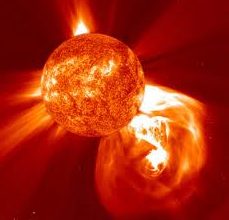NASA Image
Blog Editor’s Note: An excellent article from the NASA website below. And another example of how difficult it is for people to learn from the past and prepare for the future.
As we are fond of pointing out, the US knew aircraft hijacking was a problem before 9/11, but we didn’t reinforce cockpit doors or improve airport security. We knew the levees in New Orleans weren’t up to snuff before Hurricane Katrina, but we didn’t improve them.
We knew the sun could fry our satellites and bring our tech dependent society to its knees, but…
Link to the article below. Here are some excerpts by way of a summary:
What Happened in 1859
“The major CME event traversed the 150 million km distance between the Sun and Earth in just 17.6 hours, much faster than the multi-day period it usually takes CMEs to reach the distance of Earth’s orbit.”
“… widespread disruption to electrical … services….Upon impact, telegraph systems across Europe and North America, which took the brunt of the impact, failed. In some cases, telegraphs provided electric shocks to operators; in other cases, their lines sparked in populated areas and — in places — started fires.”
“The event produced some of the brightest auroras ever recorded in history. People in New England were able to read the newspaper in the middle of the night without any additional light. Meanwhile, in Colorado, miners believed it was daybreak and began their morning routine.”
Since Then
“…lower energy CMEs erupted from the Sun and impacted Earth in 1921, 1960, and 1989 — the latter of which caused widespread power outages throughout Quebec province in Canada. These three events are not considered to have been of Carrington-class strength.”
2012 Near-Miss
“However, a Carrington-class superstorm did erupt from the Sun on 23 July 2012 and narrowly missed Earth by just nine days, providing a stark warning from our solar parent that it is only a matter of time before another Carrington-class event impacts Earth.”
The Next Hit
“…a Carrington-class event impacting Earth today would cause between $0.6 and $2.6 trillion in damages to the United States alone and would cause widespread — if not global — electrical disruptions, blackouts, and damages to electrical grids…”
“Cascading failures of electrical grids, especially in New England…restoration estimates range anywhere from a week to the least affected areas to more than a year to the hardest-hit regions…Electronic payment systems …would likely crash… as would ATMs which rely on an internet and/or satellite link…Television signals from satellites would be majorly disrupted, and satellites, too, would experience disruptions to radio frequency communication, crippling GPS navigation.”
We Are Not Ready
“But a harsh truth remains: 161 years after the Carrington Event, the world is still not prepared for a large-scale solar storm and what it would do to us.
The nine day near miss of the 2012 Carrington-class event should have been a major wake-up call, especially given technological advancements and our dependence on it for everyday life.
But it’s warning does not appear to have been heeded as well as it should have.”
Carrington Event still provides warning of Sun’s potential 161 years later
On 28 August 1859, a series of sunspots began to form on the surface of our stellar parent. The sunspots quickly tangled the Sun’s magnetic field lines in their area and produced bright, observed solar flares and one — likely two — Coronal Mass Ejections, one major.
The massive solar storm impacted our planet on 1-2 September 1859, causing widespread disruption to electrical and Telegraph services and spawning auroras visible in the tropics.



